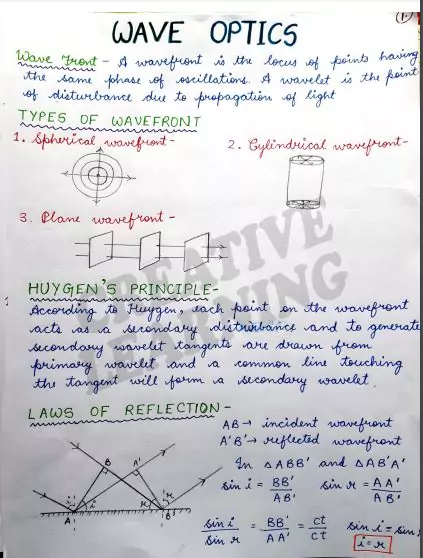‘NCERT Class 12 Physics Wave Optics Notes’ PDF Quick download link is given at the bottom of this article. You can see the PDF demo, size of the PDF, page numbers, and direct download Free PDF of ‘Wave Optics Class 12 Notes Physics Chapter 10 ‘ using the download button.
Wave Optics Handwritten Notes And Important Topics PDF Free Download

Introduction
In 1637 Descartes gave the corpuscular model of light and derived Snell’s law. It explained the laws of reflection and refraction of light at an Interface.
The corpuscular model predicted that if the ray of light (on refraction) bends towards the normal then the speed of light would be greater in the second medium.
This corpuscular model of light was further developed by Isaac Newton in his famous book entitled OPTICKS and because of the tremendous popularity of this book, the corpuscular model is very often attributed to Newton.
In 1678, the Dutch physicist Christiaan Huygens put forward the wave theory of light-it is this wave model of light that we will discuss in this chapter.
As we will see, the wave model could satisfactorily explain the phenomena of reflection and refraction; however, it predicted that on refraction if the wave bends towards the normal then the speed of light would be less in the second medium.
This is in contradiction to the prediction made by using the corpuscular model of light. It was much later confirmed by experiments where it was shown that the speed of light in water is less than the speed in air confirming the prediction of the wave model; Foucault carried out this experiment in 1850.
The wave theory was not readily accepted primarily because of Newton’s authority and also because light could travel through a vacuum and it was felt that a wave would always require a medium to propagate from one point to the other.
However, when Thomas Young performed his famous interference experiment in 1801, It was firmly established that light is indeed a wave phenomenon.
The wavelength of visible light was measured and found to be extremely small; for example, the wavelength of yellow light is about 0.5 μm.
Because of the smallness of the wavelength of visible light (in comparison to the dimensions of typical mirrors and lenses), light can be assumed to approximately travel in straight lines.
This is the field of geometrical optics, which we discussed in the previous chapter. Indeed, the branch of optics in which one completely neglects the finiteness of the wavelength is called geometrical optics, and a ray is defined as the path of energy propagation in the limit of wavelength tending to zero.
After the interference experiment of Young in 1801, for the next 40 years or so, many experiments were carried out involving the interference and diffraction of lightwaves: these experiments could only be satisfactorily explained by assuming a wave model of light.
Thus, around the middle of the nineteenth century, the wave theory seemed to be very well established.
The only major difficulty was that since it was thought that a wave required a medium for its propagation, how could light waves propagate through a vacuum?
This was explained when Maxwell put forward his famous electromagnetic theory of light.
Maxwell had developed a set of equations describing the laws of electricity and magnetism and using these equations he derived what is known as the wave equation from which he predicted the existence of electromagnetic waves.
From the wave equation, Maxwell could calculate the speed of electromagnetic waves in free space and he found that the theoretical value was very close to the measured value of the speed of light.
From this, he propounded that light must be an electromagnetic wave.
Thus, according to Maxwell, light waves are associated with changing electric and magnetic fields; changing electric field produces a time and space-varying magnetic field and a changing magnetic field produces a time and space-varying electric field.
The changing electric and magnetic fields result in the propagation of electromagnetic waves (or light waves) even in a vacuum.
In this chapter, we will first discuss the original formulation of the Huygens principle and derive the laws of reflection and refraction.
In Sections 10.4 and 10.5, we will discuss the phenomenon of interference which is based on the principle of superposition.
In Section 10.6 we will discuss the phenomenon of diffraction which is based on Huygens Fresnel principle.
Finally, in Section 10.7 we will discuss the phenomenon of polarization which is based on the fact that light waves are transverse electromagnetic waves.
| Author | – |
| Language | English |
| No. of Pages | 35 |
| PDF Size | 25 MB |
| Category | Education |
| Source/Credits | Ncrt. in |
NCERT Wave Optics PDF Free Download

very good what a wonderful you are doing for students
Physics all notes